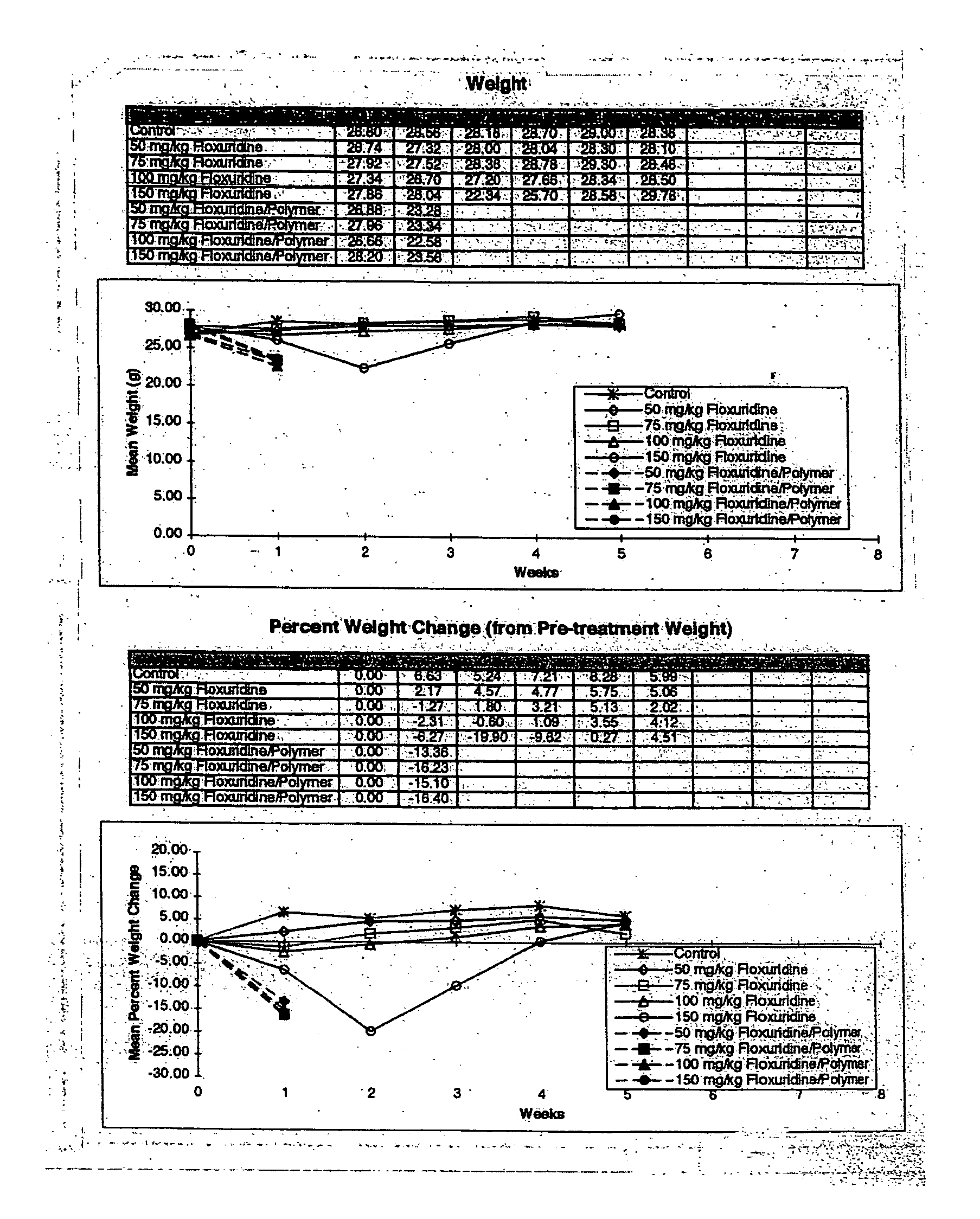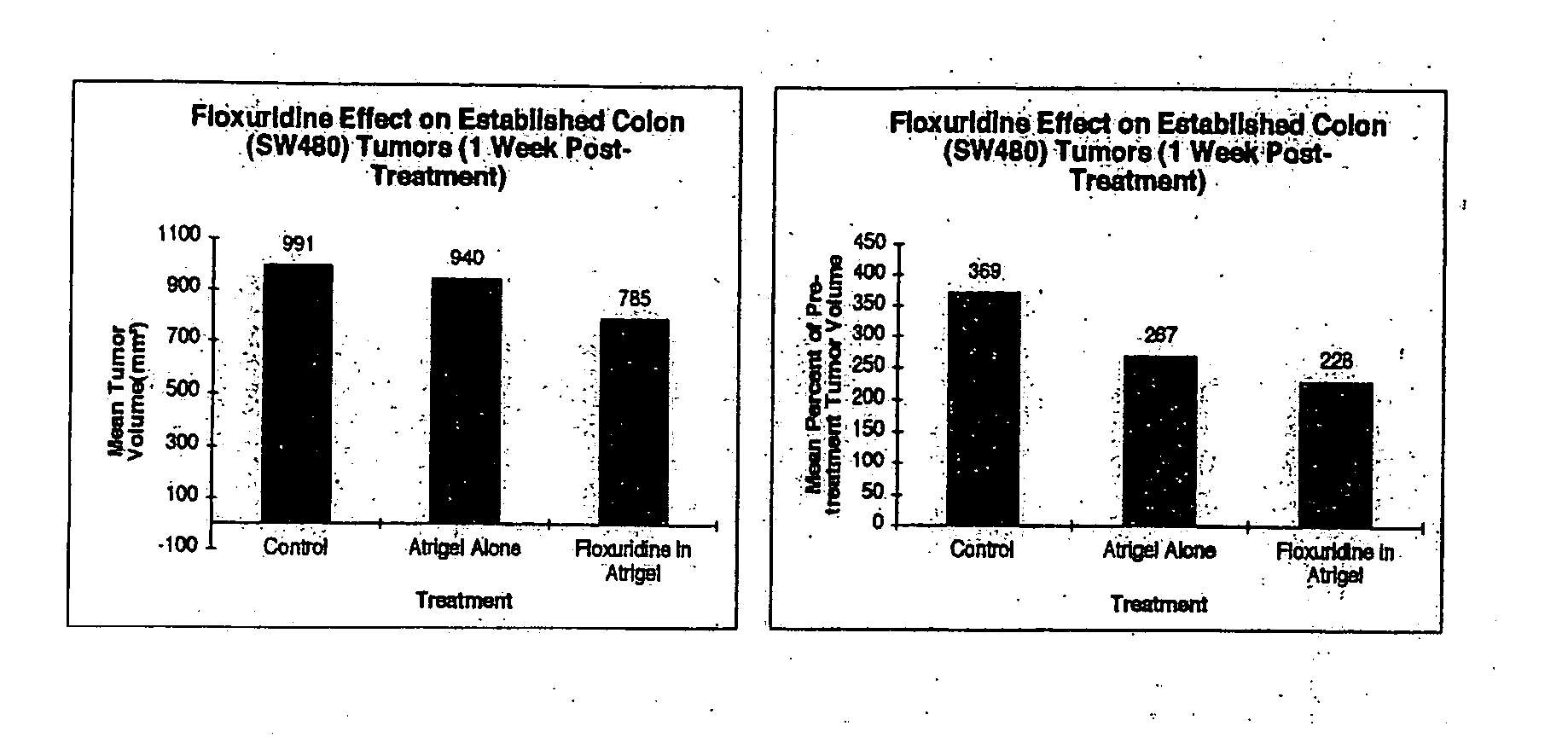Formulations for cell-schedule dependent anticancer agents
a technology of anticancer agents and forms, applied in the field of forms for cellschedule dependent anticancer agents, can solve the problems of lack of specificity, unacceptable systemic toxicity, toxicity associated with conventional cancer chemotherapy, etc., and achieve the effects of less expensive, lessening or reducing side effects associated, and improving specificity
- Summary
- Abstract
- Description
- Claims
- Application Information
AI Technical Summary
Benefits of technology
Problems solved by technology
Method used
Image
Examples
example 1
Floxuridine Dose Determination in SCID Mice
[0252] Introduction
[0253] This example was conducted to determine the Maximum Tolerated Dose (MTD) of Floxuridine in SCID mice when delivered via intraperitoneal (i.p.) injection. In order to compare the efficacy of Floxuridine delivered via the Atrix sustained release system and free Floxuridine as anti-tumor agents, the maximum tolerated dose (MTD) of Floxuridine in SCID mice needed to be established. It was hypothesized that by delivering Floxuridine in a time-release format, a higher concentration could be administered without the toxic effects associated with delivery of the free drug. A literature search indicated that the maximum tolerated dose of Floxuridine in normal mice is 50 mg / kg / day×5 days when administered by intraperitoneal injection.
[0254] Materials and Methods
[0255] In this 4-week study in SCID mice, FUDR was delivered as a free drug suspended in sterile saline. Male mice were given Floxuridine by intraperitoneal inje...
example 2
Floxuridine Dose Determination in SCID Mice II
[0269] Introduction
[0270] This example was conducted to determine the Maximum Tolerated Dose (MTD) of Floxuridine in SCID mice when delivered by either intraperitoneal injection of the free drug or by subcutaneous (s.c.) injection in a sustained release format.
[0271] In order to compare the efficacy of Floxuridine delivered via the Atrix sustained release system and free Floxuridine as anti-tumor agents, the maximum tolerated dose (MTD) of Floxuridine in SCID mice must be determined for each delivery format. It is hypothesized that by delivering Floxuridine in a time-release format a higher concentration can be administered without the toxic effects associated with delivery of the free drug. Although a literature search indicated that the MTD of Floxuridine in normal mice is 50 mg / kg / day×5 days, the initial dose determination experiment (Example 1) did not show toxicity in doses of 40 to 55 mg / kg / day×5 days. In this Example, the dose...
example 3
Floxuridine Delivered by the Atrix Polymer Sustained Release Delivery System to SCID Mice Bearing Subcutaneous SW480 (Human Colon Cancer) Tumors
[0294] Introduction
[0295] This Example was performed to determine whether Floxuridine delivered by intratumoral injection in a sustained release format via the Atrix polymer formulation will affect the growth of established tumors (subcutaneous SW480—Human Colon Cancer) in SCID mice.
[0296] Floxuridine, as a cell cycle dependent drug, is an ideal candidate for administration in a sustained release format. Floxuridine acts to interfere with the synthesis of DNA and to a lesser degree RNA. Since cells in a tumor are asynchronous, the ability to constantly supply Floxuridine to the tumor should markedly improve its effectiveness as an anti-tumor agent. In the clinic, Floxuridine is administered at 2 to 6 mg / kg given over 14 days. In order to approximate this in mice, 100 mg / kg given as a single intratumoral injection was used.
[0297] Materia...
PUM
| Property | Measurement | Unit |
|---|---|---|
| wt. % | aaaaa | aaaaa |
| wt. % | aaaaa | aaaaa |
| diameters | aaaaa | aaaaa |
Abstract
Description
Claims
Application Information
 Login to View More
Login to View More - R&D
- Intellectual Property
- Life Sciences
- Materials
- Tech Scout
- Unparalleled Data Quality
- Higher Quality Content
- 60% Fewer Hallucinations
Browse by: Latest US Patents, China's latest patents, Technical Efficacy Thesaurus, Application Domain, Technology Topic, Popular Technical Reports.
© 2025 PatSnap. All rights reserved.Legal|Privacy policy|Modern Slavery Act Transparency Statement|Sitemap|About US| Contact US: help@patsnap.com



